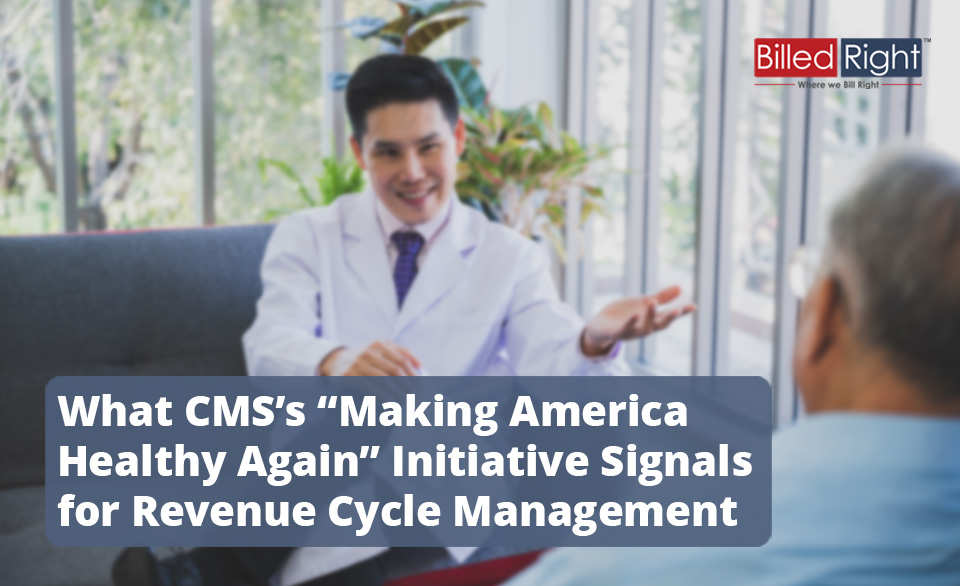What CMS’s “Making America Healthy Again” Initiative Signals for Revenue Cycle Management

In May 2025, the Centers for Medicare & Medicaid Services (CMS) published a blog titled “Making America Healthy Again: Innovation for Healthier Lives”, outlining its evolving vision for how care is delivered and paid for in the U.S. healthcare system.
For revenue cycle professionals, this announcement marks a shift in the road ahead, with direct consequences for compliance, reimbursement, and operational strategy.
The Big Shift: From Treating Sickness to Promoting Health
At the core of CMS’s new direction is a pivot from reactive care to proactive, preventive care. The agency wants to pay not just for services rendered, but for keeping patients healthy in the first place. This shift brings changes to several foundational areas of revenue cycle management:
1. Preventive Services Will Require More Sophisticated Documentation
Expect to see increased scrutiny around how lifestyle counseling, nutritional guidance, wellness visits, and similar services are recorded. These types of services haven’t always been front and center in medical documentation — that’s changing. Revenue cycle teams may need to help ensure that preventive care is fully captured and properly supported by documentation.
2. Coding May Begin to Evolve Toward Prevention
Traditional coding systems are heavily weighted toward diagnosing and treating illness. As CMS emphasizes prevention, there may be a push to refine or expand preventive codes to better reflect these services. Teams who understand the nuances of current preventive care codes will have an easier time adapting.
3. Outcome Measurement Will Become a Core RCM Concern
The initiative calls for “accurately measuring the outcomes” of preventive interventions. That means documentation will need to go beyond stating that a service occurred — it must begin to demonstrate clinical impact. This could lead to new expectations around reporting, follow-up, and data tracking.
4. Value-Based Payment Models Are Gaining More Definition
CMS isn’t just pushing for change in clinical care — it’s also signaling changes to how organizations are paid:
- Risk adjustment may require deeper, more nuanced documentation of patient complexity and social factors.
- Patient attribution models — determining which provider is responsible for which patient — may evolve to support more personalized, goal-driven care.
- Performance transparency will increase, with public reporting of cost and quality metrics across providers.
These changes mean revenue cycle teams will need to be tightly integrated with clinical operations to ensure that data is captured in a way that supports both patient outcomes and accurate reimbursement.
5. Technology Will Play a Bigger Role in Care — and in RCM
CMS highlights how artificial intelligence and digital health tools are transforming healthcare delivery. These tools, from AI-assisted clinical decisions to mobile health apps, bring new complexity to documentation and billing:
- AI-driven decisions may need to be reflected clearly in clinical notes.
- Telehealth and remote monitoring services will continue to raise coding and compliance considerations.
- Interoperability requirements may increase, as providers are expected to share quality and performance data more freely.
Revenue cycle leaders should keep a close eye on how tech-enabled care creates new documentation and coding demands.
6. Compliance Will Shift Toward Outcome Validation and Preventive Accuracy
New payment models mean new audit targets. As CMS invests more in prevention and outcome-based payments, we can expect:
- Closer reviews of preventive service documentation
- Higher expectations for outcome tracking
- Selective simplification of admin tasks, while increasing the importance of others
The compliance landscape may become more dynamic, requiring adaptable workflows and ongoing education.
What’s Next?
The details of new CMS models will roll out over time, but the direction is clear:
Healthcare organizations will be asked to prove the value of the care they provide, not just the volume.
For revenue cycle teams, this means:
- Evolving documentation practices
- Staying ahead of coding changes
- Preparing for deeper audits and data tracking
- Aligning financial processes with patient-centered care strategies
This summary reflects key takeaways from the official CMS blog post “Making America Healthy Again: Innovation for Healthier Lives”, and how its message signals a new era for revenue cycle operations. As these priorities take shape in upcoming models and regulations, staying informed — and prepared — will be critical for practices looking to stay financially sound while delivering preventive, patient-centered care.







